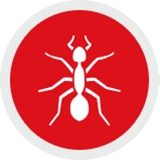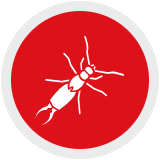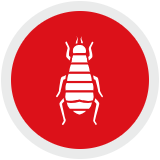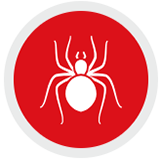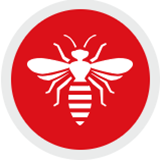Carpenter Ants (Camponotus)
Learn More About Carpenter Ants
Many people new to the Pacific Northwest are unaware that termite infestations are very rare, unlike the rest of the country. Often, people may think they see termites, but they’re actually finding carpenter ants. Carpenter ant control is extremely important in the Seattle area. Carpenter ants are the #1 wood-destroying pest in the Pacific Northwest. Left unchecked, carpenter ant colonies will cause significant damage to sound wood, possibly compromising the structural integrity of a building. If you see big black ants in or around your home, it may be time to call a professional to protect your home’s structure.
Big Black Ants
Carpenter ants are fairly easy for an untrained person to identify with the naked eye based on size and color: they are huge and usually black. The most common local species, Camponotus modoc, is “the big black ant.” Although workers vary in size within a colony, even the smallest workers are still larger than most other local ants. Insects have three body segments, and, in C. modoc, all three — the head, thorax, and abdomen — are black. The abdomen may have some silvery bands. The legs are reddish. The second most common species, Camponotus vicinus, has a black head and abdomen, while the thorax has a lighter, usually reddish, color.
| Pest Identification: | |
|---|---|
| Size | 6 to 13 mm in length |
| Color |
Black to reddish to orange to black/red combinations
|
| Body Structure |
Head, thorax, and abdomen with a small node on the pedicel.
|
| Characteristics |
Generally, there is a single queen in the colony but often supplementary queens as well. Colonies typically are around 15,000 workers when mature, but potentially could be over 100,000 workers. Foods are both carbohydrates and protein, with insects a major part of the diet.
|
| Habitat & Behavior |
Before attempting to deal with Carpenter ants, it’s important to know that there are two types of colonies – parent and satellite. A parent colony contains the queen, eggs, and early stage larvae. It is nearly always located outside the home or structure. Carpenter Ants will build trails from one colony to the next. Satellite colonies are established by worker ants. They find an appropriate place above grade (a hollow tree, a post – or a house), prepare the area (possibly by digging tunnels and chambers in good wood), and then carry larvae into the area. The larvae then pupate, and new workers emerge. A Carpenter ant colony in a structure, in nearly all cases, will be a satellite colony. Therefore, after it has been eliminated, it is essential to keep up a barrier treatment with an effective insecticide. If not treated, primary colonies will simply restock the area with new workers who will continue to damage the wood. Finding primary colonies can be very difficult, since Carpenter ants often forage hundreds of feet from the parent colony. Finding one primary colony does not necessarily protect your structure since there may be another primary colony within range of your building. Carpenter Ants control and Carpenter Ant removal can be very complicated and messy business. So it is a good idea to contact a Pest Management Professional for carpenter ant control as soon as you see signs of an infestation.
|
| Prevention & Treatment |
There are many products and methods to control carpenter ants. Choosing the best depends on the time of year, location of the nest and many other factors. When carpenter ants are seen repeatedly inside a structure, they are probably from a satellite colony and it is best to contact an experienced Pest Management Professional (PMP). Eastside Exterminators has licensed, trained Pest Management Professionals who have years of successful experience getting rid of carpenter ants and protecting homes from re-infestation. You may be interested in what NOT to do if you think you have carpenter ants. Carpenter Ant Infestation — Carpenter Ant Reproduction: After leaving the nest, the winged female carpenter ant will mate and seal herself inside a nest to lay eggs and rear the first generation of workers. The queen will lay a small number of eggs the first year and up to 30 eggs the second year. It takes about 60 days on average for an egg to become an adult worker ant. Worker ants can live up to seven years, while a queen may live up to 25 years. It usually takes several years for a colony to become large enough to produce the reproductive flying males and females. Tips for Prevention and Carpenter Ant Removal: – Remove any piles of debris, wood, and junk from around your home – Keep trees, shrubs, and plants trimmed and away from your home – Caulk cracks and crevices around foundations that provide entry from outside – Provide a dry, vegetation-free border, such as gravel or stones, around the perimeter of house foundations to discourage nest building. Wood chip mulches and landscape plants provide a good nesting environment – Keep food put away and don’t leave dirty dishes out
|

 (425) 318-7912
(425) 318-7912
 MY ACCOUNT
MY ACCOUNT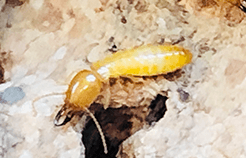
 425-318-7912
425-318-7912

